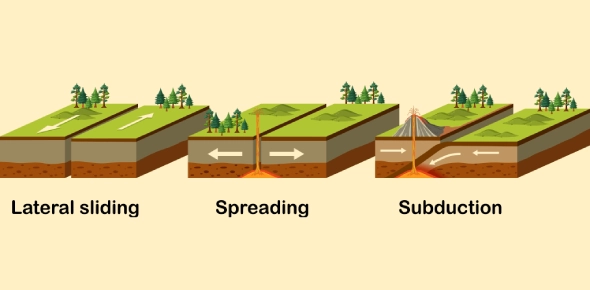Plate Tectonics: Movements, Earthquakes, and Volcanoes Explained
Lesson Overview
Tectonic plates are massive slabs of Earth's lithosphere, composed of both continental and oceanic crust, that float and move slowly over the asthenosphere. The study of tectonic plates helps scientists understand Earth's geological phenomena, including earthquakes, volcanic eruptions, and mountain building.

What Is the Structure of Earth's Interior?
Understanding the structure of the Earth's interior is crucial for comprehending plate tectonics.
Earth's Layers
- Crust: Earth's outermost layer; it is rigid, thin, and comprises continental and oceanic crust.
- Mantle: Beneath the crust, the semi-solid mantle is involved in convection currents driving plate movements.
- Outer Core: A liquid layer composed mainly of iron and nickel, generating Earth's magnetic field.
- Inner Core: The solid innermost part, primarily composed of iron and nickel, under immense pressure and heat.
What Are the Mechanisms of Plate Movements?
The primary force behind the movement of tectonic plates is convection currents within the mantle.
Convection Currents
- Process: Heat from radioactive decay in the mantle causes material to heat, rise, cool, and sink, forming circular convection currents.
- Effect: These currents exert pressure on the plates, moving them in various directions and leading to geological activity.
What Are the Types of Plate Boundaries?
The interaction of tectonic plates occurs primarily at three types of boundaries.
Convergent Boundaries
- Characteristics: Plates collide, leading to subduction or mountain formation.
- Geological Events: Earthquakes, volcanic activity, formation of mountain ranges like the Himalayas.
Divergent Boundaries
- Characteristics: Plates move apart, creating new crust as magma rises from the mantle.
- Geological Events: Formation of mid-ocean ridges and rift valleys, e.g., Mid-Atlantic Ridge.
Transform Boundaries
- Characteristics: Plates slide horizontally past each other.
- Geological Events: Frequent earthquakes, such as along California's San Andreas Fault.
What Are the Earthquake Dynamics?
Earthquakes are vibrations caused by the sudden release of energy when plates move.
Seismic Waves
- Primary Waves (P-waves): Fastest waves, moving through solids, liquids, and gases.
- Secondary Waves (S-waves): Slower waves, traveling only through solids.
- Surface Waves: Move along the Earth's surface, causing significant damage.
Epicenter and Focus
- Focus: The initial point of energy release beneath Earth's surface.
- Epicenter: Directly above the focus, the point on the surface experiencing the strongest shaking.
How to Measure Earthquakes
Understanding earthquake measurement helps scientists evaluate and communicate earthquake severity.
Richter Scale
- Measures earthquake magnitude based on seismic wave amplitude recorded by seismographs.
- Logarithmic scale: each unit increase indicates tenfold amplitude growth and approximately 31.6 times energy release.
Moment Magnitude Scale
- More accurate for large earthquakes; calculates magnitude based on fault size and displacement.
Volcano Formation and Activity
Volcanoes are geological formations created by the movement of tectonic plates.
Formation
- Occurs primarily at convergent and divergent boundaries due to rising magma.
- Hotspot volcanoes like Hawaii form due to mantle plumes away from plate boundaries.
Types of Volcanoes
- Shield Volcanoes: Broad, gently sloping; formed by fluid lava flows.
- Stratovolcanoes: Steep-sided; built from layers of lava and ash, often explosive eruptions.
Evidence of Plate Tectonics
Multiple lines of evidence support the theory of plate tectonics.
Matching Fossils
- Identical fossil types found on continents now separated by oceans.
Geological Formations
- Similar rock formations on distant continents, such as mountain ranges and ancient glacier markings.
Paleomagnetic Studies
- Alignment of magnetic minerals in rocks reveals historical plate movements.
Applications of Plate Tectonics
The study of plate tectonics has practical implications for various fields.
Resource Exploration
- Locating mineral and fossil fuel deposits related to plate boundaries and geological formations.
Disaster Preparedness
- Informing building codes, infrastructure planning, and emergency management to mitigate risks.
Rate this lesson:
 Back to top
Back to top

